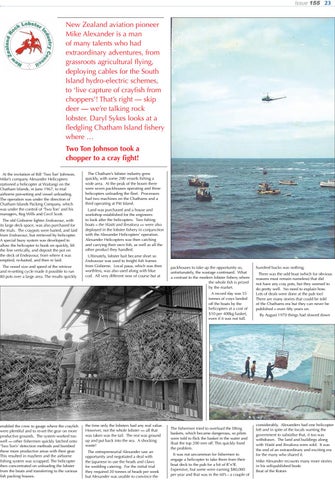Issue 155 23
New Zealand aviation pioneer Mike Alexander is a man of many talents who had extraordinary adventures, from grassroots agricultural flying, deploying cables for the South Island hydro-electric schemes, to ‘live capture of crayfish from choppers’! That’s right — skip deer — we’re talking rock lobster. Daryl Sykes looks at a fledgling Chatham Island fishery where … Two Ton Johnson took a chopper to a cray fight! At the invitation of Bill ‘Two Ton’ Johnson, Mike’s company Alexander Helicopters stationed a helicopter at Waitangi on the Chatham Islands, in June 1967, to trial airborne pot-setting and vessel unloading. The operation was under the direction of Chatham Islands Packing Company, which was under the control of ‘Two Ton’ and his managers, Reg Wills and Cecil Scott. The old Gisborne lighter Endeavour, with its large deck space, was also purchased for the trials. The craypots were baited, and laid from Endeavour, but retrieved by helicopter. A special buoy system was developed to allow the helicopter to hook on quickly, lift the line vertically, and deposit the pot on the deck of Endeavour, from where it was emptied, re-baited, and then re laid. The vessel size and speed of the retrieve and re-setting cycle made it possible to run 80 pots over a large area. The results quickly
The Chatham’s lobster industry grew quickly, with some 200 vessels fishing a wide area. At the peak of the boom there were seven packhouses operating and three helicopters unloading the fleet. Processors had two machines on the Chathams and a third operating at Pitt Island. Land was purchased and a house and workshop established for the engineers to look after the helicopters. Two fishing boats – the Waiiti and Breaksea — were also deployed in the lobster fishery in conjunction with the Alexander Helicopters’ operation. Alexander Helicopters was then catching and carrying their own fish, as well as all the other product they handled. Ultimately, lobster bait became short so Endeavour was used to freight fish frames from Gisborne. Local paua, which was then worthless, was also used along with blue cod. All very different now of course but at
packhouses to take up the opportunity so, unfortunately, the wastage continued. What a contrast to the modern lobster fishery where the whole fish is prized by the market. A record day was 55 tonnes of crays landed off the boats by the helicopters at a cost of $10 per 400kg basket, even if it was not full.
enabled the crew to gauge where the crayfish were plentiful and to re-set the gear on more productive grounds. The system worked too well — other fishermen quickly latched onto ‘Two Ton’s’ detection methods and bombed these more productive areas with their gear. This resulted in mayhem and the airborne fishing system was scrapped. The helicopter then concentrated on unloading the lobster from the boats and transferring to the various fish packing houses.
the time only the lobsters had any real value. However, not the whole lobster — all that was taken was the tail. The rest was ground up and put back into the sea. A shocking waste! The entrepreneurial Alexander saw an opportunity and negotiated a deal with the Japanese to use the heads and claws for wedding catering. For the initial trial they required 20 tonnes of heads per week but Alexander was unable to convince the
The fishermen tried to overload the lifting baskets, which became dangerous, so pilots were told to flick the basket in the water and float the top 200 mm off. This quickly fixed the problem. It was not uncommon for fishermen to engage a helicopter to take them from their boat deck to the pub for a bit of R’n’R. Expensive, but some were earning $80,000 per year and that was in the 60’s - a couple of
hundred bucks was nothing. There was the odd boat (which for obvious reasons must remain nameless) that did not have any cray pots, but they seemed to do pretty well. No need to explain how. Lots of deals were done at the pub too! There are many stories that could be told of the Chathams era but they can never be published – even fifty years on. By August 1970 things had slowed down
considerably. Alexanders had one helicopter left and in spite of the locals wanting the government to subsidise that, it too was withdrawn. The land and buildings along with Waiiti and Breaksea were sold. It was the end of an extraordinary and exciting era for the many who shared it. Mike Alexander recounts many more stories in his self-published book: Beat of the Rotors
